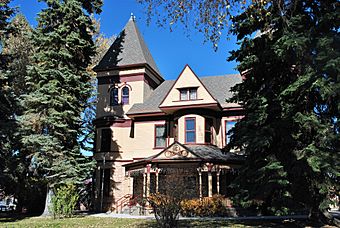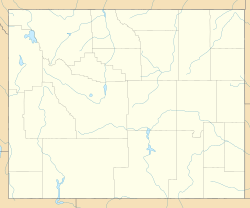Laramie Plains Museum facts for kids
Quick facts for kids |
|
|
Ivinson Mansion and Grounds
|
|
 |
|
| Location | Lots 1--8, block 178, Laramie, Wyoming |
|---|---|
| Area | 0 acres (0 ha) |
| Built | 1892 |
| Architect | Walter E. Ware |
| Architectural style | Late Victorian |
| NRHP reference No. | 72001295 |
| Added to NRHP | February 23, 1972 |
The Ivinson Mansion is a historic house in Laramie, Wyoming. It was built in 1892 by Jane and Edward Ivinson. Today, it is known as the Laramie Plains Museum.
The mansion was designed by architect Walter E. Ware. A local builder named Frank Cook constructed it. When it was finished, many people thought it was the most important house in Laramie. Edward Ivinson later gave the mansion to the Episcopal Church. They used it as a boarding school for girls until 1958.
After some years of not being used, the Laramie Plains Museum Association bought the house in 1972. Now, it is a museum where you can learn about local history. It is also used for special events.
Contents
What the Mansion Looks Like
The Ivinson Mansion is a large house built in the Victorian style. It has three floors and a basement. The house has over 11,700 square feet of space. The first floor is made of stone. The upper floors are built with wood.
The front of the house is very wide, with eight rooms across. It has beautiful wooden details, fancy tiles, and special hardware. On the left side, there is a square tower with a steep, pointed roof. It also has a round part that sticks out. On the right, there is a smaller, eight-sided tower with a curved, bell-shaped roof.
In the middle of the house, there is a porch on the first floor. It has many Victorian decorations. Above the porch, there is a curved section with a small, steep roof. The upper parts of the house show details from the Shingle style of architecture. You can see this in the curved sections and rounded window frames. The back of the house has a different roof style. It is lower and has small windows that stick out.
Other Buildings on the Property
Behind the main house, there is a brick building called the carriage house. It is about 2,600 square feet. In 1921, it was changed to be used as part of the school. It was then called the Joslin Cottage.
Another building, the Virginia Cottage, was built in 1924. It is a two-story building made of stucco and wood. It has some features similar to the Prairie Style of architecture.
The Ivinson Family Story
Edward Ivinson was born on September 20, 1830. He was born on an island called St. Croix, which was then part of the Danish West Indies. His parents were from England. Edward went to school in England. Around 1852, he moved to the United States to work in New York.
In 1854, Edward met and married Jane Wood. She was 13 years old and also an English immigrant. Soon after, the Ivinsons moved to Evansville, Indiana. Then they moved to Peoria, Illinois. In Peoria, Edward became a U.S. citizen. He worked in the dry goods business, selling things like fabric and clothing.
While in Peoria, they adopted a young girl named Margaret Ellen Watson. Her father was very sick. Edward and Jane raised her as their own child. She was their only child. Later, they moved to Memphis, Tennessee, around 1862.
Moving West and Starting a Business
In 1867, the Ivinsons decided to move to California. Edward went first. By early 1868, he decided to start a business in a place that would become Laramie, Wyoming. At that time, it was part of Dakota Territory. Jane and their daughter Maggie, who was 11, arrived in Laramie on May 10, 1868.
Edward Ivinson sold general goods and quickly made his business bigger. He also got into banking. He bought the only bank in town. Soon, he sold his dry goods store. For the next 50 years, he focused mostly on his banking businesses.
Jane Ivinson was also very active in Laramie. She helped start the local Episcopal Church. She also helped create the city's first public school. Jane was important in the social life of Laramie for many years. She was also involved in Edward's banking business. She was on the board of directors for Ivinson's Wyoming National Bank. Jane also owned land in and near the city. Much of this land was later given to the Episcopal Church through the Ivinsons' estate.
Family Life and Later Years
Maggie Ivinson married Galusha B. Grow on her 21st birthday in 1878. Galusha came from an important family in Pennsylvania. He moved west to experience life on the frontier. His uncle, Galusha A. Grow, was a famous politician who led the U.S. House of Representatives. The Grows later moved to San Diego, California. The Ivinsons had often spent their winters there.
Edward and Jane sold their shares in the Wyoming National Bank in 1888. Edward's next big banking step was buying Merchants National Bank in San Diego in 1893. Galusha ran the bank for him until he passed away in 1903. Soon after, Ivinson sold the bank for a lot of money. He then returned to banking in Laramie, Wyoming. He bought a large part of the First National Bank. He stayed in that business until 1922, when he finally retired.
Edward was asked by Wyoming Republican leaders to run for governor in 1892. Wyoming had just become a state. He did not win the election. Later, he was elected mayor of Laramie in 1918 and served one term.
Jane Ivinson passed away on November 9, 1915. After her death, Edward focused on helping others. Over the next 10 years, he paid for a new hospital in Laramie. He also helped finish the city's St. Matthews Cathedral. He built a monument to honor veterans of World War I. He also gave important pieces of property to the Episcopal Church. Many of these properties had originally been in his wife's name.
The Mansion's Legacy
In 1921, Edward gave his mansion and its grounds to the Episcopal Church. The church used the estate as a boarding school for girls. They added the Virginia Cottage in 1924. The school closed in 1958.
Edward remarried in 1921. He was 90 years old. His new wife was Augusta Haley, who was 78. She was the widow of a family friend and business partner. They lived together for only a few months before they separated and later divorced.
Before Edward Ivinson passed away, he created a special fund. This fund used all his remaining money to build and care for a home for elderly ladies. It had been a dream of his first wife, Jane, to create a place where ladies who didn't have much money could live comfortably in their later years.
Edward Ivinson passed away on April 9, 1928, at the age of 97. He was in Denver, Colorado. After he passed, the fund built the facility. It is still open today. The Ivinson Home for Ladies is in its beautiful original building in Laramie, Wyoming. It still gets some support from the Ivinson fund.
The mansion that Edward gave to the Episcopal Church was eventually left empty. It became too expensive for the church to keep up. After the school closed, the house started to fall apart. But in 1972, the Laramie Plains Museum Association bought it. They restored the house. Now, it holds the museum's collections and offices. It is also used for different events. The mansion was added to the National Register of Historic Places on February 3, 1972.



